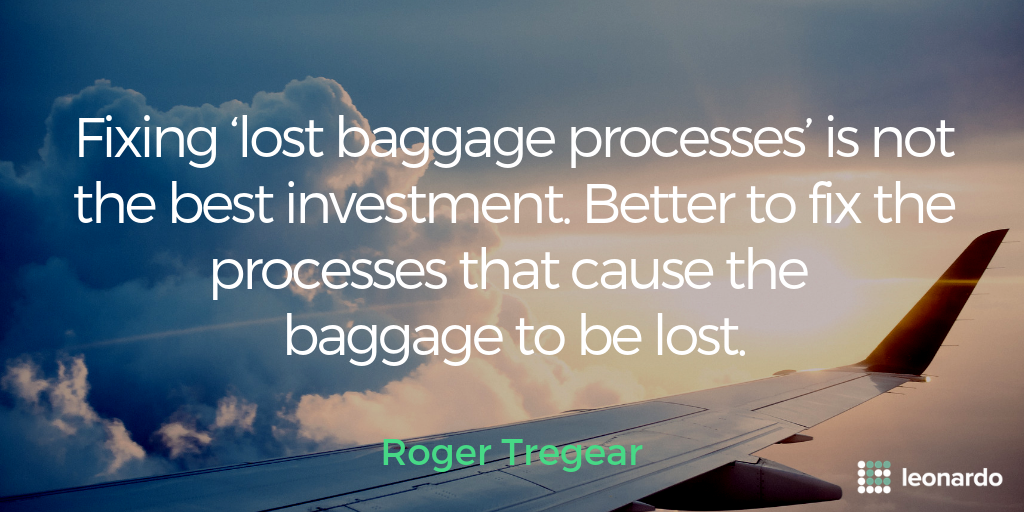 Arriving at your destination airport to discover that your checked-in bags are somewhere else is a sufficiently common occurrence to have travelers staring anxiously at the stationary carousel, then fixedly watching the point where bags are first seen, and then breathing a sigh of relief on seeing their bags finally appear.
Arriving at your destination airport to discover that your checked-in bags are somewhere else is a sufficiently common occurrence to have travelers staring anxiously at the stationary carousel, then fixedly watching the point where bags are first seen, and then breathing a sigh of relief on seeing their bags finally appear.
The problem is easing3 with the use of new technology, but millions of pieces of luggage are still being ‘lost’ each year, costing the airlines significant amounts, and causing considerable aggravation for travelers.4
Recover mishandled baggage is a process worth close attention, and it is improving. A traveler reports a missing bag, airline systems search and find it, often quite quickly, and deliver it to the traveler’s home or hotel. Job well done, baggage-handling performance targets met, congratulations all round. Except the customer, the traveler, will say that they had a terrible flight because their bag was lost.
Staff in the ‘Lost Baggage Department’ will be rightly proud of their ability to find and deliver the missing items within the target times. It’s a difficult and demanding job and they do it well. But travelers would prefer to fly with an airline that didn’t know how to find lost luggage because they’ve never needed to do so.
Organisations often invest a lot in improving the wrong processes. We get good, perhaps very good, at fixing problems that are caused by our own failures. Fixing ‘lost baggage processes’ is not the best investment. Better to fix the processes that cause the baggage to be lost. An important part of fixing a problem should be to make sure it doesn’t happen again; we don’t want to get good at fixing it.
These ‘lost baggage processes’ can appear in any part of our organisation, and we need to be constantly looking for them. If the purpose of a process is to fix a problem that should not be happening, it is by our own definitions, waste, and should be eliminated, not improved.
In the real world, there will always be ‘lost baggage’, but we must always be looking to minimise it, not to disguise it with well-practiced corrective action.
And while we are at it, let’s not be happy with just solving a problem, even if it is a massive one. Let’s also find improvement opportunities that go well beyond the need to correct performance anomalies.
Can baggage tracking innovations fix these problems?
Baggage tracking innovations involve enhanced imaging to read barcodes and recognize baggage images, and to create ‘smart bags’ by adding RFID tags or building in the technology that makes each bag a thing in the Internet of Things. Our missing bag may still fail to appear on the carousel, but it won’t be as lost as it would be now! With the real-time position and proposed itinerary of every bag known with certainty, a bag should not be able make it to the wrong truck, conveyor, bin, container, or plane.
Let’s think about the consequences—what could we do to all related processes now that we have a massive moving collection of bags, all tightly identified in a database. We might build innovations that change the whole idea of baggage transfer.
We might decouple the passenger and the baggage journeys. Your hotel might deliver your bags to the next hotel or to home. It’s a common experience to arrive somewhere and not need your checked-in baggage for many hours. You might arrive at your destination airport and walk straight to your transport, knowing that your bags will follow—or maybe are already in your transport ahead of you.
You might check-in your bags in the taxi or ride-share car on the way to the airport and just walk away (Uber Baggage?). And since there is little need to check you in for a flight (the airline already has your booking and now knows that your smartphone just entered the terminal), you no longer check in, you just arrive!
Could we create a market for spare checked-in weight? My bag is under the weight limit, and yours is over; can we do a deal? Can we create a market in ‘spare weight’ where a billion travelers do deals? No need for us to repack our bags; the airline is concerned about the total weight of the loaded plane, not our individual contributions (up to a safe maximum). If an airline can create a market that moves empty seats next to the highest bidder5 then the same can be done for ‘empty weight’.
If we had a significant amount of data about the luggage of millions, perhaps billions, of travelers, what could we do with that? We could know everything there is to know about billions of bags: model, age, current condition, condition trends, usage frequency, common itineraries, and usual packed weight. There’s an opportunity there somewhere!
Yes, I know there will be lots of problems, and real life is more complicated than typing, but too often our process improvement activities focus only on solving measurable performance problems. Our focus is to get out of the places-of-pain and into neutral, do-no-harm conditions. Beyond the negative and the neutral, perhaps there is also something positive we can do? Maybe the best improvement will come from seizing opportunities rather than fixing current problems.
Of course, we need to stop inherently wasteful activity, but obvious problems should not blind us to perhaps more powerful, but non-obvious, opportunities. Are there ways to address the promotion of well-being, as well as, or even instead of, preventing pain? Let’s eliminate waste, and nurture virtues.
Is your organization investing in lost-baggage processes? They can result in an insidious buildup of inefficiency disguised as effective high-performing processes. Seek them out. Find the opportunities. Fix the problems.
1 SITA, The Baggage Report 2017. https://goo.gl/BQUA6M. Accessed 26 June 2017.
2 Ibid.
3 United States Department of Transportation, Bureau of Transportation Statistics. https://goo.gl/UrwuV1. Accessed 30 August 2016.
4 Los Angeles Times, 29 August 2016. https://goo.gl/4mDhRH. Accessed 30 August 2016.
5 Traveller. https://goo.gl/y5Ph8E. Accessed 27 June 2017.




